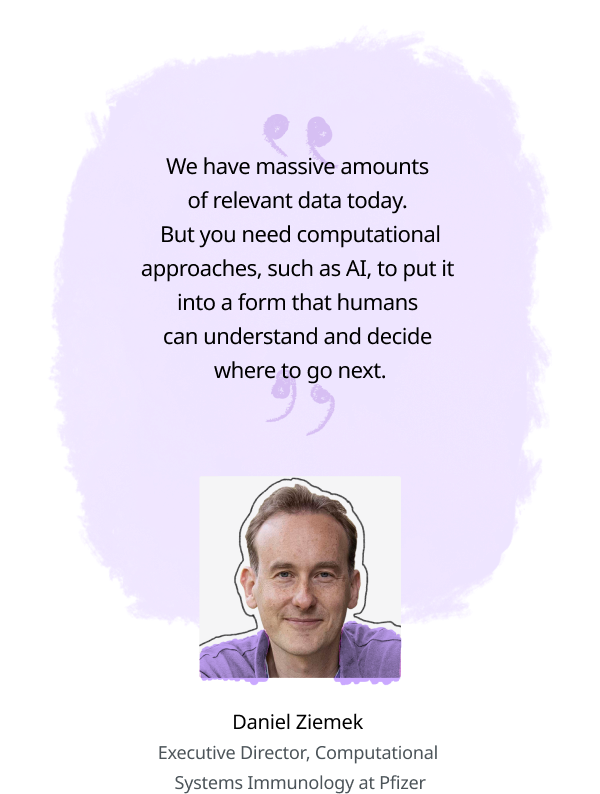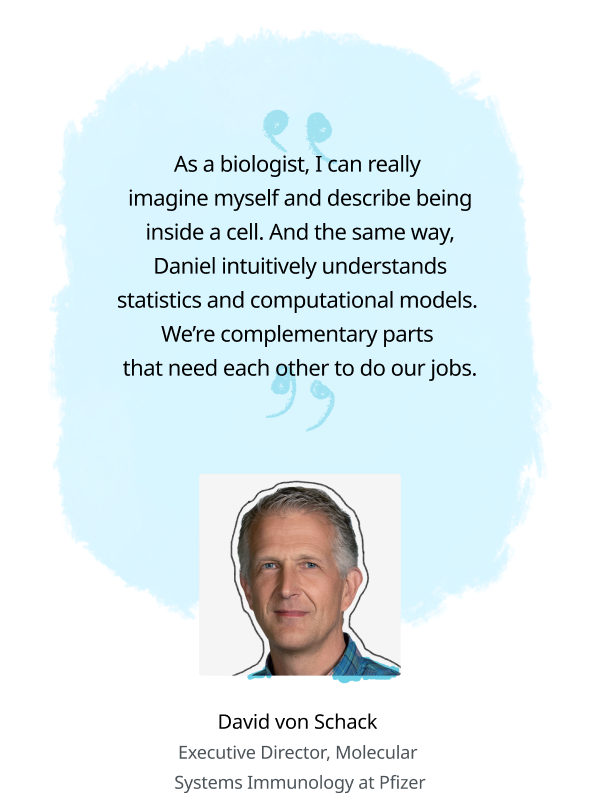- Science
- Clinical Trials
- Guide to Clinical Trials Your participation makes a difference
- Clinical Trials in Children Designed to improve kids' health
- Data and Results Sharing our Results
- Integrity and Transparency Building Trust
- Diversity Equity and Representation
- Plain Language Study Results Trial Result Summaries
- Expanded Access & Compassionate Use Possible Treatment Options
- Find a Trial
- Areas of Focus
- Rare Disease Smaller populations but big impact
- Internal Medicine Extending lifespans worldwide
- Inflammation & Immunology Treatment at the molecular level
- Vaccines Preventing the spread of infections
- Oncology The science of optimism
- Anti Infectives Combatting an evolving risk
- Areas of Innovation
- Gene Therapy Breakthroughs become treatments
- Medicinal Sciences The next generation of science
- Precision Medicine Developing tailored medicines
- Maternal Immunization Protecting newborns at the start
- mRNA Technology Unleashing the next wave of scientific innovations
- Diseases & Conditions
- Coronavirus Resources
- Product Pipeline
- Research Sites
- Clinical Trials
- Products
- How Drugs are Made
- Branded vs. Generic Learn the difference
- Biologics & Biosimilars Cures found in nature
- Commitment to Quality Maintaining the highest standards
- Global Supply Strategic manufacturing locations
- Manufacturing Sites Where medicine is made in the U.S.
- Medicine Safety
- Health Literacy Learning to be well
- Treatment Choices Learning about treatment decisions
- Partnering With Patients Helping others by reporting side effects
- Tips for Patients Preventing medication errors
- Reporting Adverse Events
- Counterfeiting Preventing medication errors
- Product Safety
- Product List
- Product Contacts
- PfizerPro for Professionals
- Patient Assistance Programs
- Distributors
- How Drugs are Made
- Stories
- Newsroom
- About
- People
- Executives Our senior-most leadership
- Board Members The people steering our company
- Scientists Our experts making discoveries
- Patient Stories Our patients
- Colleague Stories Our colleagues
- Responsibility
- Ethics & Compliance Each of us is responsible
- Responsible Business Breakthroughs that change patients’ lives
- Patient Advocacy & Engagement Putting Patients First
- Global Impact Meeting urgent needs worldwide
- Diversity, Equity, and Inclusion Everyone has something to offer
- Environmental Sustainability Our responsiblity to the environment
- Human Rights Furthering dignity and worth
- Health & Safety
- Intellectual Property The benefits of fair competition
- EHS Governance
- Misinformation
- Programs & Policies
- Grants Support for independent research
- Political Partnership Supporting like-minded organizations
- Working with Healthcare Professionals Collaboration to improve lives
- Prescription Value & Pricing How to lower patient costs
- Privacy Principles Commitment to personal data privacy
- Ready for Cures Improving Access to Medicines
- Transparency in Grants Committed to Disclosure
- Policy Positions
- Investors
- Investors Overview Information for stockholders
- Why Invest Why to join us in our mission
- Events & Presentations Calendar of upcoming events
- Financial Reports Quarterly reports and more
- Investor News Announcements about our performance
- Stock Information Charts and data
- Shareholder Services Information on stock transactions
- Corporate Governance
- Corporate Governance Overview Gaining insight into our performance
- Board Committees & Charters Defining the corporate structure
- The Pfizer Board Policies Ensuring ethical leadership
- Corporate Governance FAQs Learn more about our approach
- Contact Our Directors Email any of our Directors
- Purpose
- History
- Careers
- Partners
- People
When AI Meets Biology
Harnessing data science and technology to uncover potential new medicines
By Sachi Fujimori | July 2022
Some of the most exciting breakthroughs in medicine today are happening at the nexus of biology and computer science, using tools such as artificial intelligence (AI).
One example of this work is Pfizer’s ongoing collaboration with the tech company CytoReason to build a simulated model of the immune system. This platform can help uncover novel medicines and identify which patients will benefit most from new treatments, potentially helping to speed up and reduce the costs of developing new drugs.
But truly harnessing the power of these high-tech tools requires an AI-human partnership, where scientists with deep understanding of both biology and data science come together.
At Pfizer, two colleagues lead this partnership: Daniel Ziemek and David von Schack. At first glance they may seem to be an odd couple of sorts. Ziemek is a computer scientist and von Schack a biologist. By coincidence both are German born, but they didn’t meet until joining Pfizer, where today they head the Systems Immunology Group. The pair, and their team in the Systems Immunology Group, represent the interdisciplinary talent needed today to wield computational methods to unlock new biological insights.
Bridging the tech gap


A weather model for disease
In recent years, an explosion in biological data has been driving this field. About a decade ago, scientists could only analyze a drop of blood as a bulk sample. And now, due to advances in experimental technology (specifically a set of techniques called single-cell sequencing), scientists can zoom in on every single cell in that drop of blood.
Using traditional techniques, scientists can collect bulk data from a drop of blood.
With advanced techniques, scientists have improved resolution—gathering thousands of data points from each cell in a drop of blood.
“We used to get about 20,000 data points on what is going on in this drop of blood but now we get 20,000 data points for each of thousands of cells in that one drop of blood! At that scale, some of these AI methods have just started to become applicable,” says Ziemek.
And here's where the CytoReason platform comes in. At a high level, the platform can be compared to weather models that have revolutionized the way meteorologists predict the weather. In these models, a computer is fed large amounts of weather data—from air pressure and wind speeds to temperature and moisture. It then analyzes this information to predict the weather tomorrow or next week.
Similarly, the CytoReason platform takes data inputs from a number of sources, including published research on the immune system, Pfizer’s in-house data, and clinical studies Ziemek is careful to note that this technology is still in early stages: “Because of the complexity of human biology and immunology these models are much earlier versions compared to weather models of today. But they start to provide first insights,” says Ziemek.
For Ziemek and von Schack, it’s an ongoing collaborative process to gather just the right experimental data needed to feed the computational model. “I work in the lab to determine the appropriate experiment we can do to answer a specific question and gather data. And then, Daniel integrates all these data pieces together to allow us to ask the model the more complex questions,” says von Schack.
Here’s how Pfizer is using the CytoReason platform:
Precision medicine
Scientists select a specific disease, such as rheumatoid arthritis (RA), and gather all the available data related to that condition to create a disease model. This could include genetics, proteomics, patient data from clinical trials, and much more. When developing a new potential drug, for example, scientists can then use the model to predict which patients may best respond to the treatment. “The goal is to recreate the biology of someone with that disease and understand differences among patients,” says Ziemek. While the model is still being developed, scientists are optimistic about its future potential. This could mean testing a potential new drug in the model before it enters humans in clinical trials. “We are nowhere close to be able to do that yet, but the pace of progress is mind-boggling,” he adds.
Target finding
Scientists are also using AI technology to uncover novel drug targets in the body to make better medicines. As an illustrative example, scientists can take tissue samples from hundreds of RA patients and compare them to samples from hundreds of healthy patients. Aided by the CytoReason platform, researchers can then look for specific differences in the two groups to find potential drug targets to pursue. “Ultimately, our goal is to better understand human biology, and that will lead to better drugs that are really curative and will be transformative for patients,” says Ziemek.
With the unprecedented amount of molecular data at our fingertips today, AI has the potential to become a critical tool in helping to bring the right medicines to the right patients. And scientists’ work today is laying the foundation for that future. “Some of the most exciting applications in AI are happening with AI and human health,” says von Schack. “We need to model the diversity and complexity of the human condition so we can treat each individual patient.”


